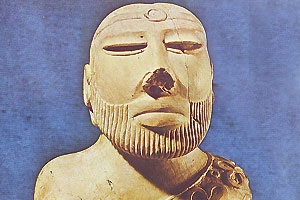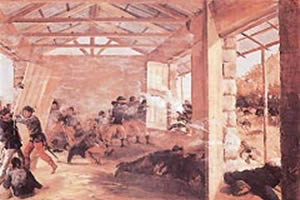The first permanent settlements on the Indus River took place as a result of the rise of agriculture in around 7000 B.C. They existed at the same time as those of the Euphrates River in Mesopotamia.
The Indus river begins in Tibet and empties into the Arabian Sea. With an average length of 3040 kilometres it now flows through the territories of India and Pakistan.
The development of these primitive inhabitants was as advanced as was their agriculture. In the fourth millennium their villages had developed a more homogenous way of life, forming the base of what would become the Indus Valley Civilization.
During its most prosperous period (2500-1800 B.C.) it is estimated that this culture would have taken in the Indian cities of Bombay in the southeast and Delhi in the east, as far as the eastern border of Iran in the west, the Himalayas in the north, and the Arabian Sea in the south, covering Afghanistan, Pakistan and part of India. In this way the sanctuary of the waters of the Indus and the other rivers of Pakistan and India was developed. It is estimated that the area of its domain was around one million square kilometres.
This was a highly urbanized civilization from which approximately one hundred settlements have been found. The largest cities were Mohenjo-Daro and Harappa, located in what is now Pakistan.
It is estimated that these cities had between 20 and 40 thousand inhabitants respectively, making them the most extensive urban areas in ancient times. They seem to have been the capitals what are currently the Pakistani regions of Punjab in the case of Harappa, and Sind in the case of Mohenjo-Daro. Both cities were built on clay mounds and both had citadels fortified by brick walls placed higher than the rest of the city. Similarly to the Greek Acropolis, the citadels enclosed main buildings.
Mohenjo-Daro, built alongside the Indus River, had twelve main streets, ranging from 9 to 14 metres in width which divided the city into twelve blocks. Eleven of these were residential. The citadel was in the twelfth block, placed on an artificial rectangular mound about 6 metres in height. It held the «Great Bath»; the «Great Granary», a building that could have been the home to a priest or some other authority and the «Assembly Hall«.
In Harappa, alongside the Ravi River, the citadel (where a centralized administration may have been located) was towards the west of the city.
The main cities of this culture in India include Ropar in the Punjab, Lothal in Gujarat and Kalibangan in Rajasthan.
The Design of the Cities
The cities, some of which were walled, were well planned. The streets were laid out in straight angles, forming squares, as in a chessboard.
They had a complex underground sewer system, unparalleled in ancient times until the Roman period, 2000 years later. They also had irrigation systems to channel water during flooding of the Indus.
As has been mentioned, the main buildings, which may have been religious, ceremonial or administrative, were in the fortresses or citadels.
The rest of the city held many houses, worker’s barracks, public buildings, granaries, shops and the workshops of artisans and metalsmiths. Religious temples, palaces, royal tombs and religious buildings have not been found.
People lived in terraced houses made of bricks and adobe. These were in narrow alleys, between the main streets. They had up to three stories, accessed by stairs that reached the roof, which was flat and supported by wood columns. The external walls were straight, without decoration or windows. These houses had many rooms. Most houses had a drainage tube in the first floor, connected to the city sewer system, a bathroom with a toilet that poured into a ceramic recipient or directly into the sewers, and a water well. Moreover, the adobe walls had a complex drainage system to drain rainwater.
The uniformity of the houses and the regular street disposition have been interpreted as reflecting rigid state control and also as the first example of urban planning in history.
Social stratification has not been able to be established, but, judging by differences in house sizes, there seems to have been some wealthier groups. In Harappa, there was a artisan neighborhood where houses had only three rooms.








 Combate de Sangra
Combate de Sangra